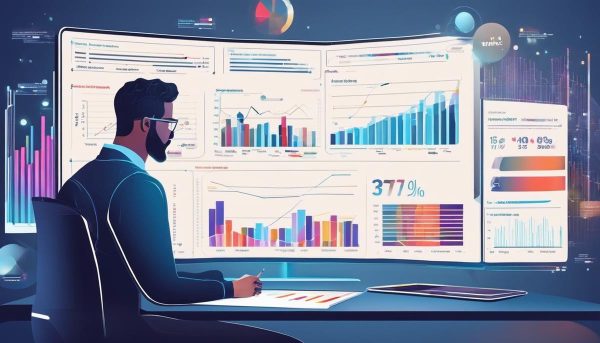Ever wondered why some businesses seem to know exactly what you want, almost like they’re reading your mind? Well, it’s not magic; it’s all about understanding the journey you take as a customer. Customer journey mapping is a super cool tool that companies use to see things from your perspective. It’s like drawing a treasure map that shows all the steps you take, from the moment you think about buying something to when you actually make the purchase and even after. By diving into this guide, you’ll learn how this map can uncover hidden treasures about what customers truly need and want, making shopping a breeze for them and helping businesses win big on customer happiness.
Understanding Customer Journey Mapping
Customer journey mapping is an invaluable tool for businesses seeking to understand and enhance their customers’ experience. At its core, this strategy involves creating a visual representation of every interaction a customer has with a brand, from initial awareness all the way through to purchase and beyond. This map is more than just a timeline; it’s a detailed account of a customer’s feelings, motivations, and questions at each stage of their journey. By putting themselves in their customers’ shoes, companies can identify pain points, streamline processes, and ensure that every touchpoint effectively meets the customer’s needs.
Understanding the customer journey is crucial because it directly impacts customer satisfaction and loyalty. In today’s highly competitive market, a business can no longer afford to offer just a great product or service; the entire experience surrounding the product or service must be exceptional. Customer journey mapping enables businesses to make data-driven decisions that can lead to improved user experience, deeper customer engagement, and increased retention rates. By anticipating customer needs and addressing them proactively, businesses can differentiate themselves from competitors, fostering a loyal customer base that feels understood and valued at every step of their journey.

Steps to Create a Customer Journey Map
Creating an effective customer journey map starts with gathering and synthesizing feedback from every point of customer interaction. Interviews, surveys, and reviews can serve as a gold mine for insights. But remember, not every bit of feedback needs a full overhaul of your process—sometimes, it’s about tweaking the existing journey to make it smoother. Once you’ve collected this data, categorize it according to the stages of your customer journey, whether it’s awareness, consideration, purchase, or loyalty. This step will highlight specific areas needing improvement and help prioritize efforts.
Next up, visualization plays a key role. A customer journey map should be more than a bunch of notes and data points—it needs to tell a story, your customer’s story. Using tools or templates can help in laying out the journey visually, making it easier to understand at a glance. This visual representation should outline the key interactions the customer has with your brand, their feelings, expectations, and frustrations at each stage. The more detailed your visualization, the better equipped you’ll be to make necessary adjustments. Remember, the objective here is not just to map but to empathize with and enhance your customer’s experience. Engage cross-functional teams in this process to ensure that changes are feasible and align with overall business objectives.

Analyzing and Interpreting Your Map
Analyzing your customer journey map involves a deep dive into the nuances of your customer’s experiences with your brand at every touchpoint. To do this effectively, start by examining the data and feedback you’ve collected to identify trends or recurring issues. Look for patterns in customer behavior, especially those that indicate a disconnect between their expectations and your service. For instance, if customers consistently abandon their cart at the checkout stage, it might indicate a problem with the payment options or the checkout process itself. By focusing on these critical junctures, you can pinpoint where enhancements are needed. Remember, the goal is to smooth out any rough patches in the journey that could detract from the customer experience.
Utilizing your customer journey map to improve your business requires actionable steps. Once you’ve identified areas for improvement, brainstorm potential solutions with your team. This might involve simplifying processes, removing unnecessary steps, or introducing new features that address customers’ needs more directly. Implement changes in stages, and closely monitor the impact on customer satisfaction and engagement. This iterative process allows for adjustments based on real-time feedback, ensuring that your interventions are effective. Engage with your customers through follow-up surveys or direct outreach to gauge their response to the changes. This not only validates your efforts but also reinforces the message that you value their input and are committed to providing a superior customer experience. Continuously refining your approach based on a thorough analysis of your customer journey map can lead to increased customer loyalty, positive word-of-mouth, and higher conversion rates.

Leveraging Technology in Journey Mapping
Embracing technology in customer journey mapping is akin to giving yourself a high-powered telescope to zoom into your customer’s experiences, needs, and expectations. In today’s fast-paced digital world, leveraging the right technology tools can transform the way businesses understand and interact with their customers. For starters, advanced analytics and AI can sift through mountains of data in real-time, offering unprecedented insights into customer behavior and preferences. This isn’t just about collecting data; it’s about decoding the story behind the numbers. Imagine being able to predict what your customers want before they even know it themselves. That’s the power of technology – it turns guesswork into a finely-tuned orchestra of customer satisfaction.
Furthermore, integrating technologies like CRM systems and customer feedback tools directly into your customer journey mapping is a game-changer. These platforms not only streamline the process of collecting and analyzing feedback across multiple touchpoints but also make it easier to personalize experiences at scale. Personalization isn’t just a buzzword; it’s what separates the good from the great in customer experience. By harnessing the capabilities of these technologies, businesses can adapt their services and communications in a way that resonates on an individual level. This approach doesn’t just elevate the customer journey; it elevates the entire brand experience, fostering loyalty, and encouraging customers to become advocates for your brand. In essence, technology is the bridge that connects your business to the hearts and minds of your customers, making every interaction count.

So, we’ve journeyed through the world of customer journey mapping together, discovering how it’s the secret sauce for businesses wanting to level up their game. It’s pretty clear that taking the time to really get this map right can lead to a pot of gold in terms of customer satisfaction and loyalty. By consistently analyzing and updating the map based on customer feedback and using the latest tech to keep things sharp, companies can stay ahead in the race to win customers’ hearts. Remember, every bit of effort put into understanding and enhancing the customer journey can transform casual shoppers into lifelong fans.



